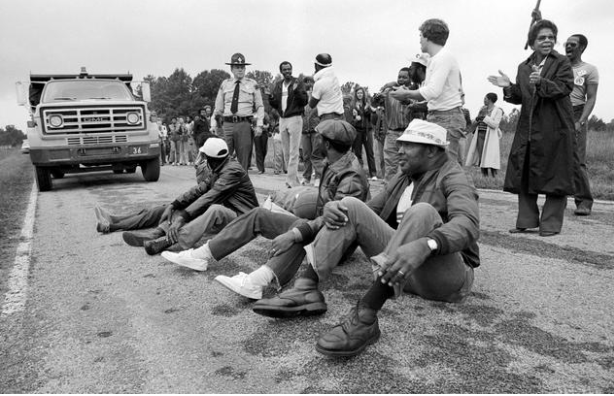
Protestors block trucks filled with toxic waste from entering a landfill in Afton, North Carolina,1982.
Photo: Ricky Stilley
During the Civil Rights movement, there had been minority-led protests concerning exposure to toxic pollution, most notably the Mexican American farm workers organized by Caesar Chavez who protested harmful pesticides they were exposed to while picking lettuce and the residents of West Harlem who protested the siting of a sewage treatment plant in their community. However, many consider the street protests and legal challenges brought by the overwhelmingly poor and minority residents of rural Afton, in Warren County, North Carolina in 1982 to be the first major milestone in the national movement for environmental justice because they drew sustained media coverage and grabbed national attention. NRDC in a 2016 blog post provided a brief historical account:
- The state decided to build a landfill in Afton to dump 6,000 truckloads of soil containing toxic PCBs.
- The state had dismissed the concerns of Afton residents, who worried about PCBs leaching into drinking water supplies.
- Frustrated residents and their supporters stopped the trucks in their tracks by lying down on roads in front of them.
- Protests and marches in Afton lasted more than six weeks and 500 people were arrested.
Unfortunately, the protests were not successful and the PCBs were eventually dumped in the landfill in Afton. But according to the NRDC, this story garnered national media attention and inspired other communities across the country who faced similar toxic injustices to speak up and press for government action. The protests also led to a General Accounting Office study published in 1983 that revealed that three-quarters of the hazardous waste landfill sites in eight southeastern states were located in primarily poor, African-American and Latino communities.
In 1990, Administrator of the EPA Bill Reilly created the EPA Office of Environmental Equity after being petitioned by several prominent African American leaders. Then, in October 1991, the First National People of Color Environmental Leadership Summit met for three days in Washington, D.C. with leaders from the United States, Canada, Central America, the Marshall Islands and elsewhere. And in 1994, President Clinton signed Executive Order 12898, which directed federal agencies to identify and address disproportionately high adverse health or environmental effects of their policies or programs on low-income people and people of color.
Why This Matters: Progress in the 25 years since Clinton’s Environmental Justice Executive Order in 1994 has been slow, but it took a decided turn for the worst with the election of President Trump in 2016. The Trump Administration’s rule rollbacks have undoubtedly had a disproportionately negative impact on poor and minority communities. The movement lives on with many heroes, like the Reverend William Barber of the Poor People’s campaign, who we profiled back in June of last year, who has made ending ecological devastation in poor communities part of their civil rights demands. And the Green New Deal is the latest manifestation of the environmental justice movement, this time with an emphasis on fighting climate change. As we recall the legacy of Dr. King today, we must remember that clean air, land, and water are things that all Americans deserve.
To Go Deeper: Read the full NRDC historical account of the Environmental Justice movement here. Or this abstract by archivist Stephen Sturgeon on the challenges of documenting the environmental justice movement for history.
January 21, 2019 » civil rights, Environmental Justice, Green New Deal, landfill, march, PCBs, protest, toxic waste


